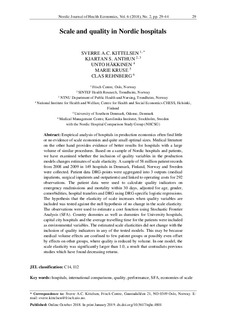| dc.contributor.author | Kittelsen, Sverre A.C. | |
| dc.contributor.author | Anthun, Kjartan Sarheim | |
| dc.contributor.author | Häkkinen, Unto | |
| dc.contributor.author | Kruse, Marie | |
| dc.contributor.author | Rehnberg, Clas | |
| dc.date.accessioned | 2019-04-02T13:53:00Z | |
| dc.date.available | 2019-04-02T13:53:00Z | |
| dc.date.created | 2019-02-05T17:08:08Z | |
| dc.date.issued | 2018 | |
| dc.identifier.citation | Nordic Journal of Health Economics. 2018, 6 (2), 29-44. | nb_NO |
| dc.identifier.issn | 1892-9729 | |
| dc.identifier.uri | http://hdl.handle.net/11250/2592991 | |
| dc.description.abstract | Empirical analysis of hospitals in production economics often find little or no evidence of scale economies and quite small optimal sizes. Medical literature on the other hand provides evidence of better results for hospitals with a large volume of similar procedures. Based on a sample of Nordic hospitals and patients, we have examined whether the inclusion of quality variables in the production models changes estimates of scale elasticity. A sample of 58 million patient records from 2008 and 2009 in 149 hospitals in Denmark, Finland, Norway and Sweden were collected. Patient data DRG-points were aggregated into 3 outputs (medical inpatients, surgical inpatients and outpatients) and linked to operating costs for 292 observations. The patient data were used to calculate quality indicators on emergency readmissions and mortality within 30 days, adjusted for age, gender, comorbidities, hospital transfers and DRG using DRG-specific logistic regressions.
The hypothesis that the elasticity of scale increases when quality variables are included was tested against the null hypothesis of no change in the scale elasticity. The observations were used to estimate a cost function using Stochastic Frontier Analysis (SFA). Country dummies as well as dummies for University hospitals, capital city hospitals and the average travelling time for the patients were included as environmental variables. The estimated scale elasticities did not change with the inclusion of quality indicators in any of the tested models. This may be because medical volume effects are confined to few patient groups or possibly even offset by effects on other groups, where quality is reduced by volume. In one model, the scale elasticity was significantly larger than 1.0, a result that contradicts previous studies which have found decreasing returns. | nb_NO |
| dc.language.iso | eng | nb_NO |
| dc.publisher | University of Oslo | nb_NO |
| dc.rights | Navngivelse 4.0 Internasjonal | * |
| dc.rights.uri | http://creativecommons.org/licenses/by/4.0/deed.no | * |
| dc.title | Scale and quality in Nordic hospitals | nb_NO |
| dc.type | Journal article | nb_NO |
| dc.type | Peer reviewed | nb_NO |
| dc.description.version | publishedVersion | nb_NO |
| dc.source.pagenumber | 29-44 | nb_NO |
| dc.source.volume | 6 | nb_NO |
| dc.source.journal | Nordic Journal of Health Economics | nb_NO |
| dc.source.issue | 2 | nb_NO |
| dc.identifier.doi | 10.5617/njhe.4801 | |
| dc.identifier.cristin | 1673797 | |
| dc.relation.project | Norges forskningsråd: 214338 | nb_NO |
| dc.description.localcode | This work is licensed under a Creative Commons Attribution 3.0 License. | nb_NO |
| cristin.unitcode | 194,65,20,0 | |
| cristin.unitname | Institutt for samfunnsmedisin og sykepleie | |
| cristin.ispublished | true | |
| cristin.fulltext | original | |
| cristin.qualitycode | 1 | |

